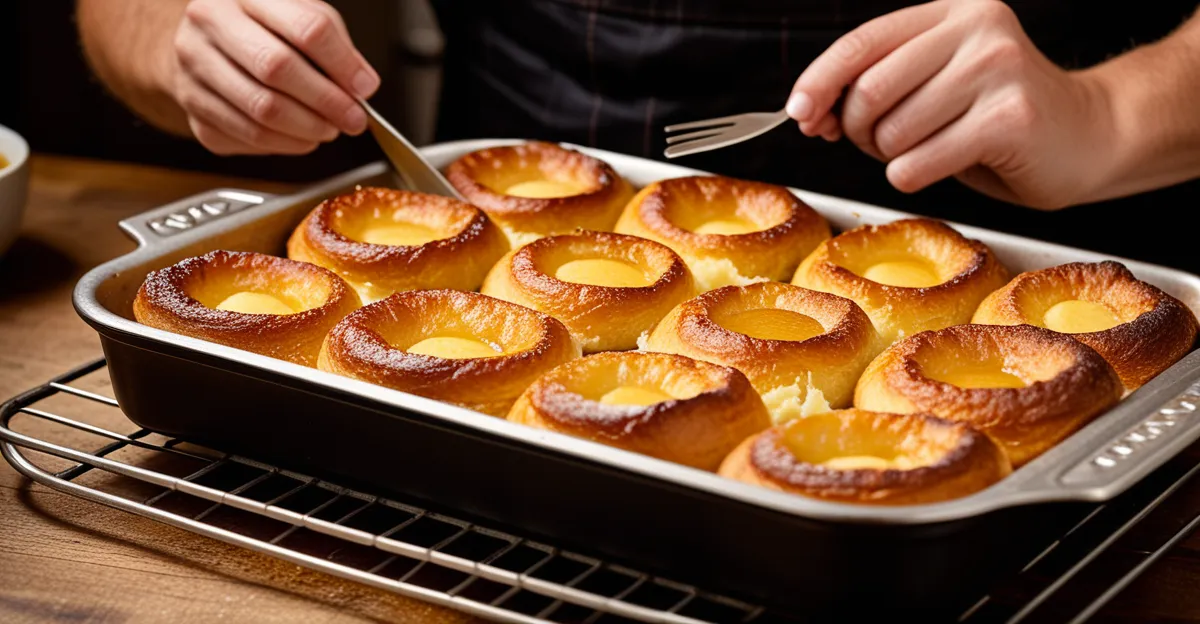Essential Ingredients and Equipment for Perfect Yorkshire Pudding
Selecting the right Yorkshire pudding ingredients is crucial for achieving the traditional rise and texture expected from this classic dish. The key components include high-quality eggs, milk, and flour ratios. Eggs provide structure and lift, so using fresh, large eggs is recommended. Whole milk contributes to the batter’s richness while keeping it light. A balanced proportion of plain flour – typically equal parts by volume to eggs and milk – ensures the pudding sets properly without becoming dense.
Equally important is using the right Yorkshire pudding equipment. Metal tins or muffin trays work best because they conduct heat evenly, promoting a crispy exterior. For the fat, beef dripping remains the traditional favorite, offering a distinctive flavor and optimum crispness, but vegetable oils with a high smoke point can also be used. The size of the tin matters; deeper tins help the pudding rise tall, while shallow ones yield wider, flatter results.
Also to read : What are the key steps to making a traditional trifle?
Preheating your preparation tools is a critical step for success. Place your chosen tin filled with fat in a very hot oven before pouring in the batter. This ensures the fat sizzles immediately upon contact, crucial for achieving a dramatic rise and golden crust. Skipping this step often results in a flat or soggy pudding.
In summary, using fresh eggs, balanced flour and milk ratios, firm but flowing fat choices, and preheated, high-conductivity tins sets the foundation for a flawless Yorkshire pudding. These successful Yorkshire pudding tips optimize both texture and flavor, delivering results that impress every time.
Have you seen this : What are the key steps to making a traditional trifle?
Expert-Approved Yorkshire Pudding Batter Techniques
Achieving the ideal Yorkshire pudding batter involves careful attention to texture and preparation. The batter should be smooth and fluid, resembling a thin pancake mix; this consistency allows for maximum expansion during baking. According to chef tips Yorkshire pudding, the key lies in balancing the Yorkshire pudding ingredients and mixing them thoroughly but gently to avoid overdeveloping gluten, which can cause toughness.
Resting the batter is a critical step many overlook. Leaving it to rest for at least 30 minutes at room temperature, or even longer in the fridge, allows the flour to fully hydrate and gluten strands to relax. This process results in a lighter, airier base that rises more effectively under high heat. Resting also brings the batter closer to room temperature, which helps it react quickly when introduced to hot fat in the oven.
The mixing method impacts rise significantly. Whisking dry and wet ingredients separately before combining reduces clumps, ensuring a uniform batter. Some chefs recommend a final vigorous whisk just before pouring to incorporate extra air, boosting lift. However, excessive beating after mixing is discouraged, as it can toughen the batter. Applying these Yorkshire pudding batter tips consistently leads to a batter that produces tall, golden puddings with hollow, crisp centers prized in traditional recipes.
Optimal Oven Settings and Heat Management
Achieving the perfect Yorkshire pudding begins with mastering the oven temperature. For optimal rise and crispness, the oven temperature for Yorkshire pudding should be very high—typically around 220°C (425°F). Preheating both the oven and the Yorkshire pudding equipment such as metal tins or muffin trays to this temperature ensures that the fat is smoking hot when you add the batter. This immediate sizzle is essential to create steam inside the pudding, promoting a dramatic rise and a golden crust.
Placement of the pudding tins inside the oven plays a vital role in even cooking. Position them on the middle rack where heat circulation is best balanced. This prevents the bottoms from burning before the puddings fully rise. Avoid opening the oven door during the initial baking phase; even a slight temperature drop can hinder the batter’s expansion and lead to flat results.
Maintaining steady heat throughout the baking process is another critical point in baking tips for Yorkshire pudding. The oven should not be turned down once baking starts. If the temperature dips too low, the puddings will not crisp properly and may become soggy. Using a reliable oven thermometer helps monitor actual temperature because many household ovens vary from their set temperature.
In summary, high preheated temperatures, careful positioning, and consistent heat are essential for producing perfect Yorkshire pudding with the signature puff and crunch that defines this classic British dish.
Step-by-Step Cooking Instructions
When learning how to make Yorkshire pudding perfectly, mastering the pouring and baking stages is essential. Pour the rested, smooth batter carefully into the preheated tins containing smoking hot fat. This immediate contact between Yorkshire pudding batter and hot fat triggers the crucial sizzle that creates steam, driving the batter’s expansion. Pour enough batter to fill the tins about halfway; overfilling restricts rise, while underfilling yields smaller puddings.
Baking time normally ranges from 20 to 25 minutes at the recommended high temperature. Yorkshire pudding step-by-step guidance emphasizes not opening the oven door during this period. Opening it too soon causes heat loss, which halts rise and may lead to sogginess or collapse. Patience here guarantees a crisp, puffed result with a hollow interior.
Knowing exactly when your pudding is ready relies on visual and textural cues. The puddings should have a deep golden-brown colour with edges crisped to perfection. A gently firm top signals full cooking without dryness. Pressing the top lightly should reveal a hollow center underneath, indicating proper puff and moisture balance. Removing them promptly from the hot tins onto a wire rack prevents steaming and sogginess.
These successful Yorkshire pudding tips ensure each step—from pouring hot fat to timing the bake precisely—maximizes your pudding’s iconic rise and crispness. Following this Yorkshire pudding process carefully transforms a simple batter into the impressive, traditional dish beloved across Britain.
Troubleshooting and Common Mistakes to Avoid
When facing issues with your Yorkshire pudding, understanding Yorkshire pudding troubleshooting is essential. A common problem is flat or soggy puddings. This typically results from the fat not being hot enough when the batter is poured. The immediate sizzle from hot fat creates steam necessary for the rise; without it, puddings remain dense and limp. Ensuring that the Yorkshire pudding equipment—especially tins—is thoroughly preheated along with the fat can prevent this mistake.
Another frequent error is overmixing the batter, which develops gluten excessively, leading to toughness instead of the desired lightness. This highlights the importance of following precise Yorkshire pudding batter tips, mixing gently, and resting the batter to relax the gluten.
If your puddings collapse or fail to hold their shape, opening the oven door too early or uneven oven heat could be to blame. Maintaining a consistent, high oven temperature for Yorkshire pudding without interruptions avoids temperature drops that hinder rising.
For last-minute quick fixes, if the batter seems too thick and resistant to rising, gently whisking in a small amount of milk can loosen consistency, encouraging better puff. Additionally, switching from vegetable oil to beef dripping or a high-smoke-point fat can enhance crisp edges.
By recognizing these common mistakes and applying practical Yorkshire pudding troubleshooting strategies, you can rectify issues and enjoy consistently successful bakes.
Insider Tips, Chef Insights, and Proven Secrets
Unlocking the full potential of your Yorkshire pudding requires diving into chef secrets Yorkshire pudding often reserved for professionals. One expert Yorkshire pudding advice highlights the importance of selecting the right fat combined with specific heat strategies. While beef dripping remains classic, some chefs blend it with sunflower oil to balance flavour and smoke point, enhancing crisp edges without burning.
A lesser-known trick involves briefly whisking the batter again just before pouring, injecting extra air to boost loft—part of trusted Yorkshire pudding pro tips. Additionally, some chefs recommend adding a pinch of baking powder to the batter, which can subtly aid rising for an even taller puff, without compromising traditional texture.
Regional variations also offer valuable insights. In Yorkshire proper, large, deep tins are preferred to maximize height, while southern recipes may favour wider, shallower tins for broader, crisper puddings. Recognizing these nuances enriches your approach and respects the dish’s heritage.
Beyond ingredients and oven settings, expert Yorkshire pudding advice stresses timing precision—pouring batter immediately into smoking hot fat produces the essential steam that sets the structural rise. Many professionals also suggest briefly resting the cooked puddings outside the oven on a wire rack to prevent sogginess from trapped steam, ensuring each pudding remains perfectly crisp.
Mastering these chef secrets Yorkshire pudding guarantees your bakes achieve the optimal combination of height, texture, and golden crunch, elevating your culinary results to a truly authentic experience.
Frequently Asked Questions and Visual Guides
Understanding common queries about Yorkshire pudding helps ensure baking success. One frequent question is: What is the ideal consistency for Yorkshire pudding batter? The answer is that the batter should be smooth and fluid, similar to a thin pancake batter, allowing it to rise properly without becoming dense. Achieving this balance relies on the correct mix of Yorkshire pudding ingredients—notably the right flour to liquid ratio—and thorough but gentle mixing, as emphasized in many Yorkshire pudding batter tips.
Another common question is: How do I know when my Yorkshire pudding is perfectly cooked? Visual cues provide the best guidance. Look for a deep golden-brown color with crisp, well-risen edges, and a slightly firm top that, when gently pressed, reveals a hollow center beneath. This indicates the optimal texture and rise, consistent with successful Yorkshire pudding tips that stress timing and heat control during baking.
For those wondering about equipment, a key question is: What kind of tins and fats yield the best results? The use of metal tins or muffin trays is recommended because they distribute heat evenly, crucial for even puffing and browning. Beef dripping remains the traditional fat for added flavor and crispness, but high smoke point vegetable oils can also work well. Preheating the Yorkshire pudding equipment with the fat until smoking hot ensures the batter sizzles immediately, a step vital for rise and texture.
Visual guides typically illustrate these points: an ideal batter thickness flowing easily from a spoon, tins filled only halfway to allow expansion, and finished puddings with a tall, hollow structure. Such aids clarify the process and help bakers troubleshoot common issues simply by referencing appearance.
In summary, combining expert answers from Yorkshire pudding FAQs with clear visual cues empowers bakers to recognize and achieve the perfect batter and final pudding, enhancing confidence and results in each bake.

